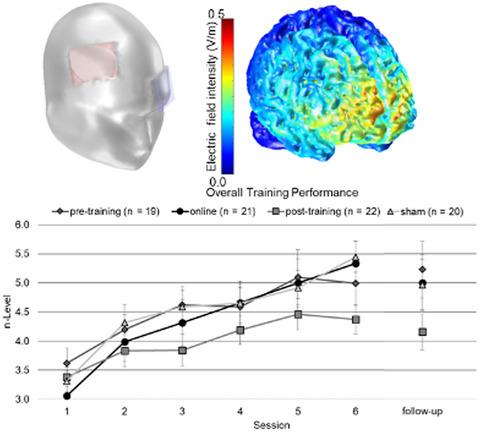当前位置:
X-MOL 学术
›
J. Neurosci. Res.
›
论文详情
Our official English website, www.x-mol.net, welcomes your
feedback! (Note: you will need to create a separate account there.)
Post-training stimulation of the right dorsolateral prefrontal cortex impairs working memory training performance
Journal of Neuroscience Research ( IF 2.9 ) Pub Date : 2021-01-12 , DOI: 10.1002/jnr.24784 Jacky Au 1 , Benjamin Katz 2 , Austin Moon 1 , Sheebani Talati 3 , Tessa R Abagis 3 , John Jonides 3 , Susanne M Jaeggi 1
Journal of Neuroscience Research ( IF 2.9 ) Pub Date : 2021-01-12 , DOI: 10.1002/jnr.24784 Jacky Au 1 , Benjamin Katz 2 , Austin Moon 1 , Sheebani Talati 3 , Tessa R Abagis 3 , John Jonides 3 , Susanne M Jaeggi 1
Affiliation

|
Research investigating transcranial direct current stimulation (tDCS) to enhance cognitive training augments both our understanding of its long-term effects on cognitive plasticity as well as potential applications to strengthen cognitive interventions. Previous work has demonstrated enhancement of working memory training while applying concurrent tDCS to the dorsolateral prefrontal cortex (DLPFC). However, the optimal stimulation parameters are still unknown. For example, the timing of tDCS delivery has been shown to be an influential variable that can interact with task learning. In the present study, we used tDCS to target the right DLPFC while participants trained on a visuospatial working memory task. We sought to compare the relative efficacy of online stimulation delivered during training to offline stimulation delivered either immediately before or afterwards. We were unable to replicate previously demonstrated benefits of online stimulation; however, we did find evidence that offline stimulation delivered after training can actually be detrimental to training performance relative to sham. We interpret our results in light of evidence suggesting a role of the right DLPFC in promoting memory interference, and conclude that while tDCS may be a promising tool to influence the results of cognitive training, more research and an abundance of caution are needed before fully endorsing its use for cognitive enhancement. This work suggests that effects can vary substantially in magnitude and direction between studies, and may be heavily dependent on a variety of intervention protocol parameters such as the timing and location of stimulation delivery, about which our understanding is still nascent.
中文翻译:

右侧背外侧前额叶皮层的训练后刺激会损害工作记忆训练表现
研究经颅直流电刺激 (tDCS) 来增强认知训练不仅增强了我们对其对认知可塑性的长期影响的理解,也增强了其在加强认知干预方面的潜在应用。之前的工作已经证明,将并发 tDCS 应用于背外侧前额叶皮层 (DLPFC) 时可以增强工作记忆训练。然而,最佳刺激参数仍然未知。例如,tDCS 传输的时间已被证明是一个有影响力的变量,可以与任务学习相互作用。在本研究中,我们使用 tDCS 来瞄准右侧的 DLPFC,同时让参与者接受视觉空间工作记忆任务的训练。我们试图比较训练期间提供的在线刺激与训练前或训练后立即提供的离线刺激的相对功效。我们无法复制之前展示的在线刺激的好处;然而,我们确实发现证据表明,相对于假训练,训练后提供的离线刺激实际上可能会损害训练表现。我们根据表明正确的 DLPFC 在促进记忆干扰中发挥作用的证据来解释我们的结果,并得出结论,虽然 tDCS 可能是影响认知训练结果的有前途的工具,但在完全认可之前还需要更多的研究和充分的谨慎。它用于认知增强。这项工作表明,不同研究之间的影响在幅度和方向上可能存在很大差异,并且可能在很大程度上取决于各种干预方案参数,例如刺激传递的时间和位置,对此我们的理解仍处于萌芽阶段。
更新日期:2021-01-12
中文翻译:

右侧背外侧前额叶皮层的训练后刺激会损害工作记忆训练表现
研究经颅直流电刺激 (tDCS) 来增强认知训练不仅增强了我们对其对认知可塑性的长期影响的理解,也增强了其在加强认知干预方面的潜在应用。之前的工作已经证明,将并发 tDCS 应用于背外侧前额叶皮层 (DLPFC) 时可以增强工作记忆训练。然而,最佳刺激参数仍然未知。例如,tDCS 传输的时间已被证明是一个有影响力的变量,可以与任务学习相互作用。在本研究中,我们使用 tDCS 来瞄准右侧的 DLPFC,同时让参与者接受视觉空间工作记忆任务的训练。我们试图比较训练期间提供的在线刺激与训练前或训练后立即提供的离线刺激的相对功效。我们无法复制之前展示的在线刺激的好处;然而,我们确实发现证据表明,相对于假训练,训练后提供的离线刺激实际上可能会损害训练表现。我们根据表明正确的 DLPFC 在促进记忆干扰中发挥作用的证据来解释我们的结果,并得出结论,虽然 tDCS 可能是影响认知训练结果的有前途的工具,但在完全认可之前还需要更多的研究和充分的谨慎。它用于认知增强。这项工作表明,不同研究之间的影响在幅度和方向上可能存在很大差异,并且可能在很大程度上取决于各种干预方案参数,例如刺激传递的时间和位置,对此我们的理解仍处于萌芽阶段。











































 京公网安备 11010802027423号
京公网安备 11010802027423号